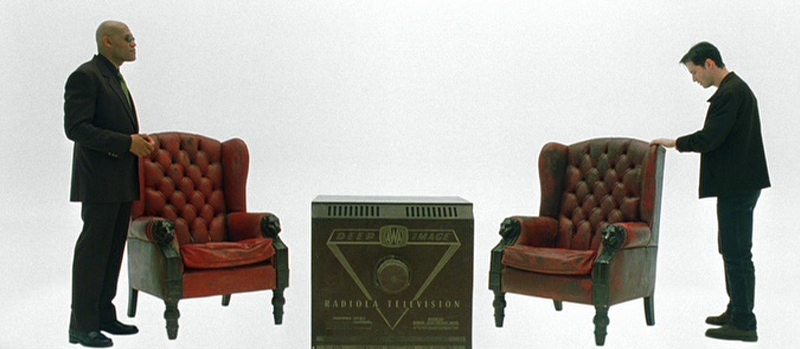
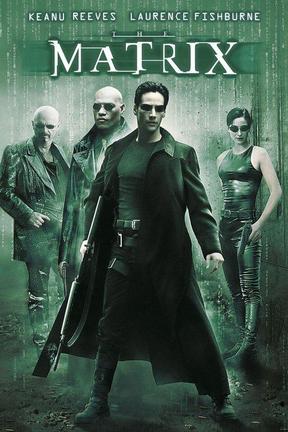
“This is your last chance. After this, there is no turning back. You take the blue pill—the story ends, you wake up in your bed and believe whatever you want to believe. You take the red pill—you stay in Wonderland and I show you how deep the rabbit-hole goes.”
In 1999, the Wachowskis’ techo-futurist mind-bender was unleashed upon the world. Spawning the “red pill” meme and proving increasingly prescient with each passing year as society is sucked more and more into their virtual lives, the sci-fi blockbuster balances the tightrope between action and intelligence, featuring stunning choreography and set pieces as well as providing plotlines that prompt the viewer to ponder the film’s ideas outside of its fictional framework. With a singular blend of martial arts, mind-bending premise, mythology, armchair philosophy, religious allusion, and innovative visual effects, The Matrix remains one of the pinnacles of the action movie genre—a high-water mark that has seldom been matched in the ensuing years. In other words, it was a game changer.
Imagine, for a moment, a group of prisoners chained up in a cave; immobile, only able to gaze at the wall of the cave in front of them. They have been kept this way since birth. Behind the prisoners, a fire burns steadily, a puppeteer is situated on his parapet, and shadow puppets cast upon the wall are all that the prisoners can see. Unless the prisoners are freed and can turn and look at the puppeteer (or leave the cave), they will continue to believe that the shadows upon the wall are reality; that the shadows are the objects they represent. This is Plato’s Allegory of the Cave, one of the many philosophical influences integrated into The Matrix. In the film, a computer wiz code-named Neo (Keanu Reeves) is contacted by a wanted hacker, Morpheus (Laurence Fishburne), who explains that Neo has lived his entire life inside of a computer simulation, along with the rest of humanity, mistaking his virtual existence for reality.
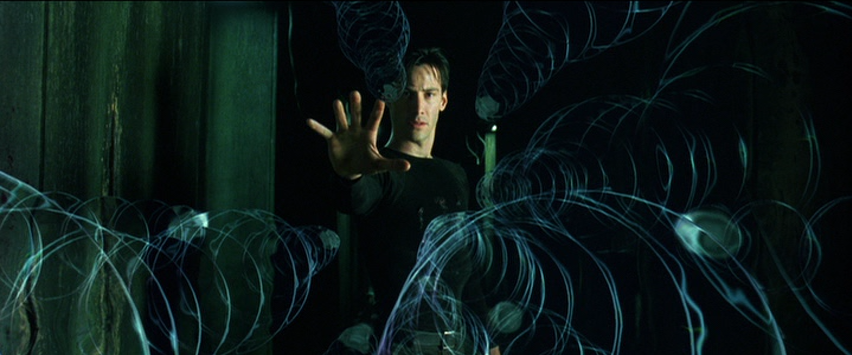
Morpheus speaks cryptically and through additional simulations he informs Neo of the true state of things. In the late 20th century, humans experimented with AI, and created sentient machines that eventually fought back against their creators, culminating in a war between man and machine. In a last ditch effort to cut off the autonomous machines’ power supply, humans “scorched the sky” to block the sun, but soon the machines began harvesting energy from humans themselves. Now, humans are grown in embryonic pods arrayed for economical storage and use; they are kept unconscious and have their minds plugged into a simulation of the year 1999 that keeps them blissfully unaware of their essential function as batteries for their robotic overlords.
Neo is removed from the Matrix and wakes up naked, weak, and hairless in a pod of goo; a series of tubes are semi-permanently permanently attached to his spinal cord and another runs down his throat. He is brought aboard Morpheus’s ship, the Nebuchadnezzar, where his atrophied muscles and unused eyes are treated so that he can function in the outside world. “Why do my eyes hurt?” Neo asks. “You’ve never used them before,” Morpheus replies. Of course, he must go back into the Matrix, and he must be better prepared than he was previously. Because the Matrix is computer code, Neo is able to have different programs loaded into his arsenal—kung fu, jiu jitsu, gunplay, etc.—cheat codes, basically.
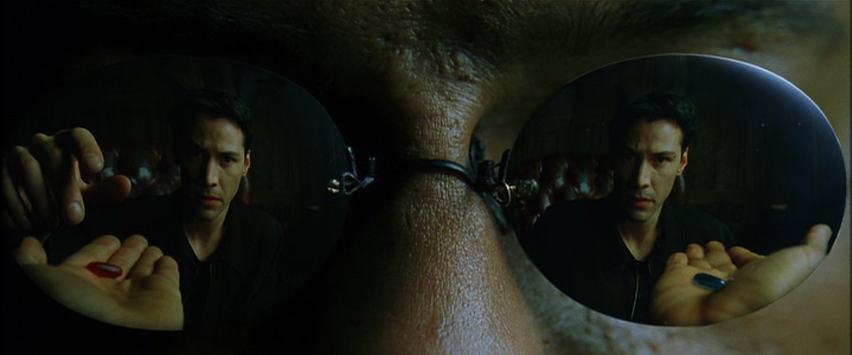
This is all well and good, but if everyone can do this, why do we care about Neo? Why hasn’t Mouse (Matt Doran) just written a program that allows Morpheus, Trinity, or even himself to defeat the ubiquitous Agents and conquer the machines? Well, because the Matrix still constrains its users to the basic physical laws of the real world. But The Oracle (Gloria Foster) has prophesied that there will be one who conquers the machines, and that Morpheus will rescue The One from the Matrix. (The mysterious mythology is a bit handwavy, and you kind of just have to go with it for now, but it receives a more robust treatment in subsequent films.)
So Neo is (maybe) The One. When he goes to meet The Oracle himself, he waits in a room with other potential messiahs, who have displayed nascent abilities. Neo begins to grasp his own powers when a young boy demonstrates that he can bend a spoon with just his mind. “Do not try and bend the spoon. That’s impossible. Instead, only try to realize the Truth: There is no spoon. Then you’ll see that it is not the spoon that bends, it is only yourself.” But just as soon as Neo begins to believe in himself, The Oracle tells him that he is not The One.
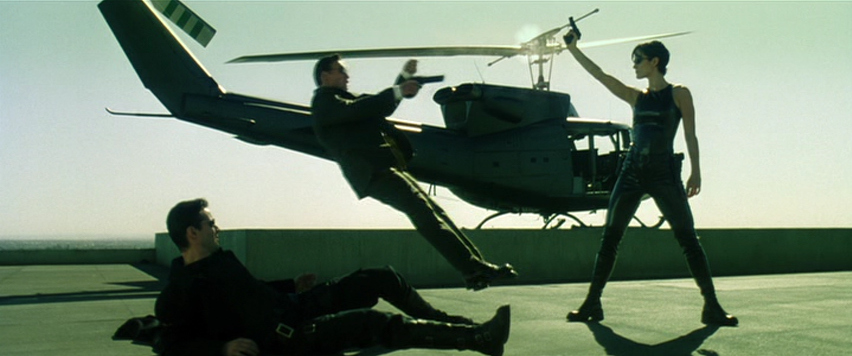
The plot continues formulaically—betrayal, rescue mission, half-baked love story, etc. But the plot is not what makes The Matrix compelling. It is the provocative philosophical questions, the iconic style, and the masterful action sequences. In the Matrix, the machines present themselves as Agents—programs that appear human in form, but inhuman in ability. They can take over the simulacra of unwitting humans at any time, and so every person the protagonists encounter in the Matrix must be suspect.
The machines are represented by Agent Smith (Hugo Weaving) and a couple of cronies. Except for a brief simulated fight between Morpheus and Neo, the extended martial arts scenes feature Agent Smith. Mixed in there is plenty of gunfighting and chase scenes, featuring wired acrobatics overseen by Yuen Woo-ping.1 Using computer simulations to determine positioning, an array of cameras were set up to allow the filmmakers to utilize time-slice photography, stopping time (Neo stopping bullets mid-flight) and slowing it down (Neo limboing under a barrage of bullets).2 These moments represent instances when characters exert control over the Matrix. Designer John Gaeta cited the anime film Akira (1988) as a visual inspiration. Another anime, Ghost in the Shell, is also a clear inspiration—stylistically, thematically and narratively.
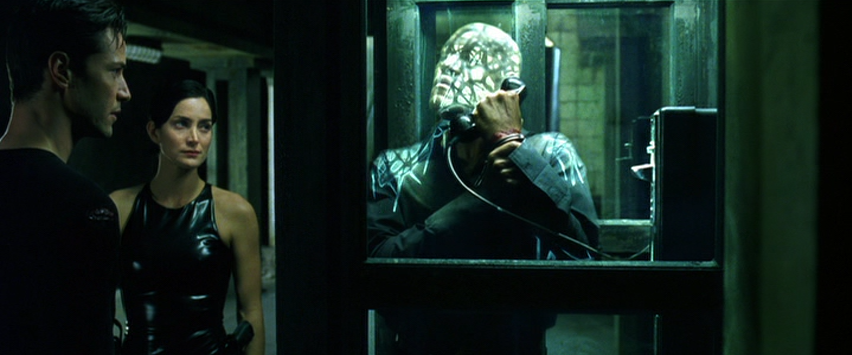
The Wachowskis were not shy about sharing their influences. In the realm of cinema, The Matrix was inspired by the Hong Kong action films of John Woo (The Killer, Hard Boiled), contemporary sci-fi film Dark City, and other Japanese animated films including Ninja Scroll and Nausicaä of the Valley of the Wind. In comics, Grant Morrison’s The Invisibles and Frank Miller and Geof Darrow’s Hard Boiled had a notable influence on the film (Darrow served as a storyboard and concept artist on The Matrix). William Gibson’s cyberpunk Neuromancer served as a useful literary source, while Kevin Kelly’s nonfiction Out of Control3 served as a sociological framework. The Exegesis of Philip K. Dick, a collection of his journal entries, posits simulation theory and may have proven influential along with his fictional works such as The Man in the High Castle. Jean Baudrillard’s Simulacra and Simulation—a philosophical treatise which argues that our society has replaced reality with symbols and signs—even appears on screen in the film.
Additional philosophical influences include the aforementioned Allegory of the Cave, Socrates’ visit to the Oracle at Delphi, Meditations on First Philosophy by Descartes, and Immanuel Kant’s Critique of Pure Reason, which could each lead down their own separate rabbit holes.4 Religious allusions abound, most prominently a slew of parallels between Neo and Christ (“virgin” birth, prophesied coming, betrayed by a follower, Anderson translates from Greek as “son of man”). There is plenty to dig into for anyone interested in doing so, though many articles and analyses already exist, along with a wealth of bonus materials in The Ultimate Matrix box set, including The Matrix Revisited where many of these influences are discussed. Several books have attempted to analyze the concepts in the film, such as The Matrix and Philosophy: Welcome to the Desert of the Real, a compilation of essays put together by William Irwin.
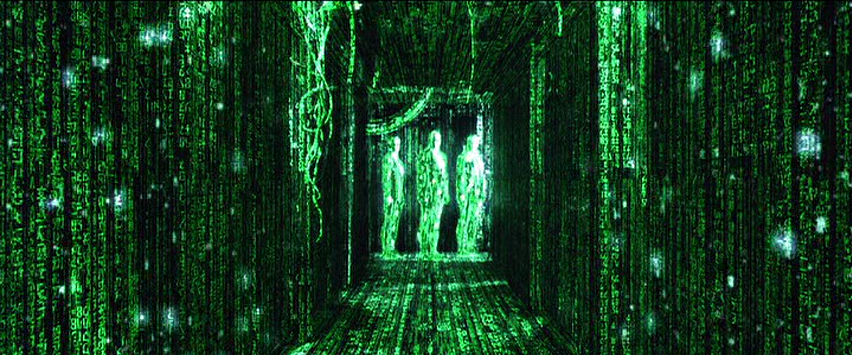
The common criticisms of the film—wooden acting, a hero that does not earn his mantle, a premise sparked by unease about middle class life instead of ecological disaster, under-developed philosophical framework, flimsy romance—are mostly valid, but do not subtract from the film’s achievement. The film’s scope was huge, and it mostly hit all of its beats and stuck the landing. These complaints are mostly from people who are looking for things that were never on the table to begin with—in my estimation, from perusing the thoughts of the Wachowskis, they accomplished nearly everything they set out to do with The Matrix. The only knocks that I think make sense are possibly the lack of romantic scenes between Trinity and Neo coupled with the plot’s reliance on it late in the story, and the film’s heavy use of then-current technology and music. The music still sounds pretty good (Rammstein, Rage Against the Machine, Rob Zombie, Marilyn Manson, etc.) even if its currently not in style. The early cell phone that Neo uses to speak to Morpheus and the late 90s office look dated now, but the Matrix is perpetually set in 1999 so it is technically accurate. The computer systems outside of the Matrix—supposedly from several decades into the future—don’t look very futuristic now (especially compared to something like Minority Report which still looks futuristic today). But futuristic science-fiction films that don’t look dated a couple of decades after their debut are the exception to the rule, and the few instances where The Matrix hasn’t aged well are minor and inconsequential. For the most part, it is still fresh and invigorating.
Warner Bros. took a chance on The Matrix, and it paid off in spades. It was an audacious, original, brainy film that had to fire on all cylinders to work, and as such was something of a risk, one which is too seldom taken by studios today. The film’s influence is hard to overstate, from bullet time and wired kung fu, to its iconic style, to its integration of brains and brawn, to its multi-format storytelling.5 The Matrix was a watershed moment in film history; it has had a vast influence on blockbuster cinema and has proven itself a prescient commentary on modern society’s relationship with technology. If you have been living under a rock for the past 20 years you should make it a priority to see it.
1. Woo-ping’s success with The Matrix would lead to similar work on Crouching Tiger, Hidden Dragon (2000), Kill Bill Vol. 1 (2003), Kill Bill Vol. 2 (2004), and The Grandmaster (2013).
2. The technique utilized to slow time down, rather than stop it, is much more complicated than the regular time-slice technique. In order to capture movement, the still cameras must fire in a predetermined sequence; and since several of these ultra-slo-mo scenes feature 360 degrees, the cameras had to be painted out later. Front and back of the action, regular film cameras continued to roll in order to make the action feel seamless. It is neat to think about, because you could conclude that you are being fooled into thinking the rapid series of pictures has convinced your brain that it is film—but film itself is just a series of pictures too.
3. The book is subtitled “The New Biology of Machines, Social Systems, and the Economic World” and puts forth the theory that intelligence is not concentrated in any centralized structure, but instead spread out amongst many smaller components.
4. I once wrote a term paper on the modern individual’s relationship to technology using the Matrix trilogy as a sounding board.
5. The film would spawn two sequels—The Matrix Reloaded (2003) and The Matrix Revolutions (2003)—but its story was also spread across a number of other mediums. The Animatrix is a collection of short anime films which expand the history, settings, and concepts of the story. A trio of videogames utilized scenes shot during the production of the sequels, and told stories that occurred in parallel with those in the sequels. A series of comic books (released in omnibus form in 2019 as The Matrix Comics) also fleshes out the Matrix universe, and were considered even before the first movie had started production.
Sources:
Green, Dave. “Better Than SFX”. The Guardian. 5 June 1999.
Burns, Chris. “Bullet Time: a short history between 1877 and 3D surfing”. Slash Gear. 9 November 2011.